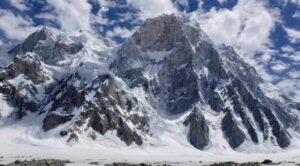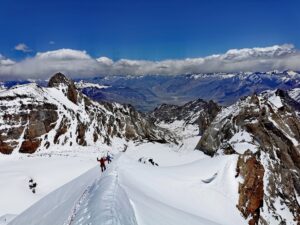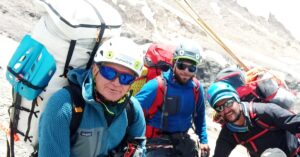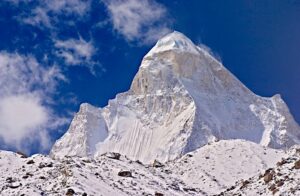Nirmal Purja intends to lead a commercial expedition to the south side of Cho Oyu in autumn 2022. And Purja is not the only one with that idea.
Gelje Sherpa cites this goal as his “next challenge”. Maya Sherpa had hoped to try it this fall. Most of Nepal’s outfitters are keen to take part in a government-funded venture that could change the high-altitude business in the country.
So why would business-oriented Nepali leaders invest resources and their own safety on a mountain face that only a handful of hard-core alpinists have climbed before? Because this difficult and dangerous face offers both high risk and high reward. Here is some context.
Forbidden Tibet
Word is, China will not allow foreign climbers across its borders next spring, either. All those eager to tackle Shishapangma, Cho Oyu, or Everest’s North Side to will have to wait until Chinese authorities decide that the COVID crisis is finally over. Perhaps not coincidentally, the two characters (危機) for “crisis” in Chinese mean “risk” and “opportunity”. This certainly applies to Cho Oyu, the 8,188m Turquoise Goddess. But it is Nepal that is taking the risk for the opportunity.

Andrzej Zawada’s 1985 Polish expedition opened Cho Oyu’s SE Pillar in the winter of 1985. Photo: SummitPost
In Nepal, expedition outfitters have been trying to figure out a way to guide their clients up what used to be considered the “easiest” of the 14 8,000’ers. They all have concluded that the only solution lies somewhere on the south face, within Nepal.
In fact, across the Nangpa La lies the Khumbu Valley and the beautiful Gokyo lakes, so a Cho Oyu Base Camp would be convenient, scenic, and just a few kilometres from Everest. The problem is that there is no remotely easy line on the Nepal side of Cho Oyu.
Cho Oyu’s wild side
Cho Oyu’s south side can be divided into the Southwest Face in Tibet, the South Ridge along the border, and the large South-Southeast Face in Nepal. Compared to the straightforward normal route up Tibet’s Northwest Ridge, the south side of Cho Oyu is vertical, ragged, and avalanche-prone. It’s rarely attempted and even more rarely summited. Yet it is not impossible.

Will outfitters dare to commercialize Denis Urubko’s 2009 route? Photo: RussianClimb
The first ascent of Cho Oyu from Nepal was in 1978, up the extremely risky South Face. The two Austrians, Edi Koblmuller and Alois Furtner, made only the second overall ascent of the peak at that time.
The Polish winter warriors made perhaps the most remarkable ascent in mid-February 1985, without oxygen. Maciej Berbeka and Maciej Pawlikowski summited first, opening a new route on the SE Face. Andrzej Heinrich and Jerzy Kukuczka, who had just climbed winter Dhaulagiri, followed some days later.
Then in 2009, the sublime Denis Urubko finished his 14×8,000’ers quest in grand style by opening ‘Reincarnation‘ in pure alpine style, with Boris Dedeshko. Climbing from the south, the pair tackled a more exposed line than the Polish route, which it joins at 8,000m.
Also worth a mention, and a tribute, is the line that an iron-willed Russian team opened in 1991 on the East Ridge. They first summited Gyachung Khan, then traversed to Cho Oyu! Only five of the 14 members of the team made it to the summit. One died from a falling rock during the descent.

All Cho Oyu routes, compiled by the Animal de Ruta blog. The four climbs done from the Nepal side are numbers 15 by Urubko, 4 by the winter Polish team, 2 the 1978 Austrian ascent, and 8 the Russian line along the East Ridge.
The S-SW Ridge route?
In their excellent review of Cho Oyu routes, the authors of the Argentinian blog Animal de Ruta suggest that those daring to tackle Cho Oyu’s wild side might try the S-SW Ridge, on the border between Tibet and Nepal. As they see it, it is a logical and doable route.
But we should bear in mind that their suggested route mounts a 6.5km-long ridge, with nearly 2,900 vertical metres from base to summit. While an attractive challenge for a small team of strong, highly skilled climbers, it may not be ideal for fixing ropes from bottom to top for large, guided, heterogeneous groups.
“That’s why we are trying to find possible safe routes,” Maya Sherpa told Stefan Nestler in 2020. She was involved in the project as vice president of the Nepal Mountaineering Association (NMA). Back then, Maya Sherpa said that they were awaiting funds but trusted that the expedition would come off in the fall of 2020. In the end, it didn’t.
In June 2021, in an interview with The Himalayan Times, Mingma G called upon Nepali tourism authorities to prioritize a commercial route up Cho Oyu from Nepal. He pointed out the financial potential of such a project. He bluntly criticized Nepal’s Department of Tourism for missing such a golden opportunity at a time when many Nepalis were jobless because of the relatively low number of climbers due to COVID.
But fall 2021 came and went, and no one tried to climb Cho Oyu. So Mingma G instead turned the industry upside-down by guiding his clients to the true summit of Manaslu while everyone else stopped at a foresummit.

Mingma G on Manaslu’s true summit last month. Photo: Mingma G
Gelje’s incentive
Yet the buzz about upcoming attempts to Cho Oyu hasn’t stopped. Gelje Sherpa, fresh from guiding Manaslu, Kangchenjunga, and Ama Dablam, has posted “Next plan: Cho Oyu (from Nepal)” at the head of his Instagram profile. Gelje is currently working to become the youngest climber to achieve the 14×8,000’ers. He now has only two remaining, Cho Oyu and Broad Peak. So he has a strong incentive to launch that project as soon as possible.
Mingma G detailed for ExplorersWeb the current state of the Cho Oyu idea.
“As far I know, Nims wants to lead a commercial team on Cho Oyu next October,” he told us. “Also, the Government of Nepal has allocated 30,000,000 rupees — around US$250,000 [for outfitters to open a route on the S Side of Cho Oyu].”

Satellite images with the potential route on Cho Oyu, courtesy of Mingma G.
Mingma G confirmed that he had been researching possible routes. Recalling his previous demands to the Ministry of Tourism, he explained that the problem was the country’s political instability after its latest change of government.
“It took almost six months to appoint a new Tourism Minister,” he said. “These sort of projects are considered national [in scope] and need to be approved at the highest level. Our new Tourism Minister was finally appointed in October, and there was no time to plan it for this year.”
Asked about the options for a safe route, Mingma G didn’t hesitate. “Yes, it is possible,” he said. He also shared a map of one potential line up the mountain. Two photos in this story also show key sections.

A potential route. Courtesy of Mingma G.
However, if the project finally launches next year, Mingma G will not be part of it. He will be busy managing and leading expeditions to 8,000’ers all year long. His work begins with Dhaulagiri, Everest, Lhotse, and Kangchenjunga in spring, K2 and Broad Peak in summer, and Manaslu plus another (new) peak in fall.
“I am not sure who may lead or [join] the future Cho Oyu team,” Mingma G said. It was the umbrella organization, the Expedition Operators Association, supported by other groups, that applied for project support, rather than one or two outfitters.

Cho Oyu, showing one possible access to the summit ridge. Courtesy of Mingma G
Certainly opening a route up an 8,000m peak will be difficult, especially if it involves the weight of bottled oxygen and the labor of rope fixing along the way.
Obviously, the Nepali teams are not looking for a Piolet d’Or-winning ascent. They are simply seeking the safest route in order to extend their business area. The difficult routes will remain for those who want them.






